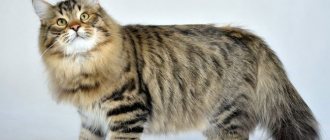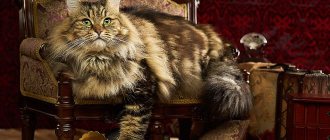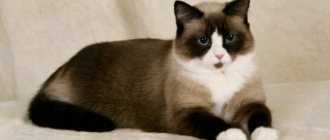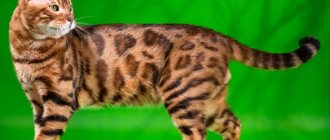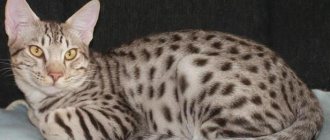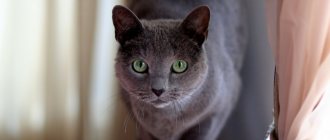This article will provide a complete description of the Siberian red cat. The animal’s character, appearance, size and maintenance rules do not differ from its relatives of other colors. Just like all other Siberians, this purr is endowed with an impressive size, but is graceful and noble. Man did not take part in breeding the breed; the Siberian red cat received all its external and characteristic features from nature - harsh climatic conditions contributed to the development of all the qualities inherent in the breed. If you doubt whether such a pet is suitable for your home, then read the publication where you will learn everything about this beautiful animal. Photos of red Siberian cats are included in the article, and you will be able to appreciate the beauty of the animal.
History of the breed
Siberian cats were first mentioned in the 16th century, but the large animal had a different name - Bukhara. By the way, this name of the breed is still preserved in the Volga region. Then there are records from the 18th century, which say that along the Silk Road, merchants brought a rather expensive, but very large and beautiful cat to the territory of the Russian state.
How did the red Siberian cat appear in Siberia? This is unknown. People from all over our beautiful planet came to explore this harsh region, and any of them could have brought an animal that eventually took root in such harsh conditions.
There is a version that the birthplace of the Siberian breed is Bukhara. But the Bukhara cats known today have an even more interesting coat, which they obtained as a result of crossing with a wild steppe and forest cat. But the fact that the Siberian red cat has wild ancestors is a fact. It was from their wild ancestors that the Siberians received their endurance, hunting skills, strength and some exterior features.
And yet, whatever one may say, the Siberian breed is indigenous. Breeders didn't even have to bother getting a certificate. It was only necessary to improve the gene pool, and crossing with very similar eastern breeds helped with this.
Blue cat
photo: Blue color
The Siberian blue cat has gained its popularity not only in Russia, but also abroad. The long neck, elongated body, and long cone-shaped tail determine its recognition among other breeds. The paws are round and high.
The coat color of this breed is silver with a soft blue tint. The coat is thick and uniform, as is the undercoat. The wool does not contain any patterns, buttons, or stains. The eyes are in their normal position and are not recessed deep into the skull. In all other cases, it is either an admixture in the pedigree or a defect.
The blue Siberian cat got its color by crossing silver and one of the non-dominant colors. The result was a uniform color throughout the entire coat, without pigments.
An independent character gives this person a sense of self-worth and importance in this world. The Siberian Blue cat will never impose itself or allow you to pet it when you want it. But when the cat is in a good mood, then please. At home it is peaceful. Sometimes he shows his hunting instincts.
Breed recognition
Despite the fact that the Siberian red cat, a photo of which can be found in the article, became known since the 16th century, the breed was recognized only at the end of the 20th century. The first registered animal of this breed was a cat named Roman, and this event happened already in 1987.
Since the world recognized the Siberian cat, it has become one of the most popular and sought-after breeds. Siberian cats today are not valued as mousecatchers (as was the case before the breed was recognized), but are distributed all over the world as pets, and they certainly no longer need to worry about food.
Existing colors
Surely you have seen what a Siberian cat is like. Photos of furry beauties are constantly published in magazines. Today there are many color options for these cats, and they all appeared as a result of selection. None of them can be found in the natural environment. Everything here should be functional, the natural color of Siberians is the one that helped them survive and camouflage in nature. This is a combination of black, gray, red and white shades. This color is the calling card of the Siberian, but, unfortunately, it is not popular. If there is an exhibition in which a Siberian cat is participating, the photo shows blue, red and other representatives of this breed. Although in this color it is difficult to recognize the true owner of the Siberian forest.
What other types of cats are there? For example, pure white, shiny. Only the nose and paw pads remain pink. Amazingly beautiful, but too “sofa” cats. Their fur will quickly get dirty, especially if the cat has access to free walks around the garden area. The opposite is the black Siberian cat. This is a coal-black animal. Even the nose and paw pads are usually black. Only the eyes are saturated green or blue.
The Siberian red cat is very popular. This color is a symbol of a kindled hearth, sunshine, summer. There are several shades, ranging from fiery red to pale straw. And although this is an atypical color for a Siberian, many people dream of just such a kitten. His paw pads are usually brick red. In addition, there is a registered cream color. Delicate pastel shades look elegant; in this case, the cat’s nose and paws are pink.
The Siberian blue cat looks very interesting. In this case, the color should be uniform throughout the body. Smoky shades of gray are acceptable. The nose and paws are also blue. Such kittens are sorted out first. There is a tortoiseshell color - black with red spots. Tricolor cats are considered to be white cats with black and red spots. The muted tricolor color is not so widespread - these are white cats with blue and cream spots.
Animals with fur of the same color as chinchillas look elegant. This is a light color at the base of the coat and darker tips. A silver effect is created (for example, pure white wool with dark tips). Thus, the colors of Siberian cats can be golden, silver, smoky, tabby, brindle, marbled.
Description of the Siberian red cat
The breed is spectacular due to its incredibly powerful physique. The cat is muscular, has powerful bones, and the fluffy coat gives even more power to the already not small animal. Despite their enormous size, Siberians are very kind.
Many cat lovers who are allergic to animals may be put off by the presence of a large amount of fur. But, despite the length and thickness of their fur coat, Siberian cats are completely hypoallergenic and do not pose a threat to human health. Grooming is also not particularly difficult, but required.
Shorthair cat
photo: Smoky Shorthair
The Siberian Shorthair cat also belongs to the type of long-haired individuals. This breed originated in the Siberian Islands, with the participation of breeds from Britain and the European continent. Unlike the previous breed, its size does not exceed average. By color they can be tortoiseshell, chinchilla, plain or smoky.
It is distinguished by its slightly shortened paw length. The tail is not very long, the head is rounded, large in size, a massive strong neck, medium ears, the forehead is stretched slightly forward, and the nose, on the contrary, is recessed. The coat is short and of equal length.
Calm, difficult to succumb to aggression. Education does not allow you to react aggressively or attack an animal in the fight for an object, territory or food. Being self-confident, they will conquer whatever they like without difficulty or fight.
The Siberian smooth-haired cat is loyal only to its owner, easy to find a common language, and clean. Willful - will not allow you to dictate your terms. Requires proper care. Just like long-haired cats, this cat needs to be brushed to remove excess fluff. Even if the nutrition is correct, it will still be there, just not enough.
Standards
Despite the fact that the breed appeared on its own, without the help of breeders, it still has standards that distinguish a true breed (without crossbreeds or defects):
- The main distinguishing feature is its enormous size. If the average weight of a cat is 6 kilograms, then a cat is already 12.
- The muscularity of a cat, but such a physique is formed over three years. Therefore, you should not worry about the purity of the breed if your one-year-old “baby” differs in physique from its relatives.
- The physique is squat, monolithic, and this gives greatness to the breed.
- The incredible strength and agility of cats is due to their body structure. The hind legs are somewhat longer than the front legs, and thus the spine becomes sloping.
- The paws are large and strong, the soles are wide, and there is long and thick hair between the toes - the result of centuries of existence in harsh climatic conditions, the features of a predator.
- The head is spherical and large in size. And at the same time, the animal’s neck is short, but strong and powerful.
- The shape of the muzzle is trapezoidal.
- From its wild ancestors, the Siberian red cat received small, cute tassels on the tips of its ears.
- The eyes are slanting, medium in size, and widely spaced.
- Gorgeous, thick fur, which in cold times saved animals from freezing. Thicker and longer hair is found on the collar, belly, and panties; it can be not only straight, but also curly.
- The aura of a real hunter, which is felt when meeting an animal. This is explained by the piercing gaze and appearance of the cat.
This is the standard of the Siberian red cat. As you can see, there is nothing special that needs to be carefully considered and measured when choosing a kitten.
Fold cat
photo: Siberian Fold
The Siberian Fold cat, like all characteristic cats, is devoted to its beloved owner. He is a great friend for everyone in the household. Playful, loves to roll on the floor with her belly up. Adults are difficult to train and re-educate. You need to start from early childhood. She is vindictive. In retaliation for your screams, he will shit in your slippers or drop a vase of flowers. It is not recommended to shout at her.
It is very similar to Scottish, but still it is ours, Russian! The folded ears lie close to the head. Sometimes fur appears in clumps in the area of the paws. It has a water-repellent wool structure. Large, round eyes of any color. Green is not allowed.
The character is calm, loyal to everything and everyone, proud. It's more difficult with children. She doesn't really like being pestered by children and may bite or snort. It is better to choose this breed at five months. This way you can accurately determine the true breed of the cat, and they won’t be able to slip you a tartan.
Features of color
What is the color of the red Siberian cat? The animal can be monochromatic, and the color varies from rich red with redness to brown. Shades of wool can be golden, cream, silver. Solid color is the rarest.
The color may be monochromatic, but with the presence of stripes that are the same color, but of a darker tone. The most common color of the Siberian cat is red and white. The base is red, and the shirt front and paws are white.
Health
These fluffies don't complain about him. Of all the representatives of the cat world, they are the hardiest, strongest, and, moreover, long-lived. But do not neglect the rules of vaccination, because viral diseases are easier to prevent than to treat. It is also necessary to carry out prophylaxis against parasites twice a year. Add to this proper nutrition and regular walks in the fresh air, and you have the ideal scheme for ensuring that your pet will delight you for many years.
As cats age, they may become more lethargic and slower. These are normal age-related changes that do not pose any danger. If the cat begins to choke or cough, this may indicate a disease of the cardiovascular system. In any case, it is necessary to seek help from a veterinarian in a timely manner. When purchasing a pet, you must provide a separate expense item. Doctor's help may be required at any time, and today it is quite expensive.
Character
These are playful, active animals that need somewhere to put their energy. By nature, Siberian cats are hunters, but today it is a rare person who will buy an expensive animal for catching mice in a private home. If you live in an apartment and there is no need to clear it of rodents, then you need to buy toys for your pet on which the hunter will practice his skills and satisfy his instincts.
By the way, these are not at all picky animals when it comes to toys. If the cat has driven all its balls and bells under the sofa, it may steal some of the owner's accessories, so if hair ties, cosmetics and other things are missing, look under the furniture.
The character of the Siberian red cat is good-natured and soft. The animals are not vindictive, very loyal to their owner (chooses one from all family members), and smart. They quickly remember the name and will not respond to other words. Accustoming to basic rules of behavior, a scratching post and a tray, will not take much effort and time, since the Siberian breed is endowed with a lively mind!
These huge purrs love to sit by the water, or even take a swim. In order for the animal to have fun and release energy, you can fill the bath with water, put toys in it, the cat will be happy to pull objects out of the water.
If a cat sits somewhere on top, watching life in the house, this is normal. The animal does not hunt, just a craving for heights and observations is in its blood.
Castration and sterilization
Castration involves the complete removal of the reproductive organs with the cessation of hormonal function. Sterilization is carried out to prevent the birth of offspring. From the point of view of the animal's future life, castration is considered a more humane operation. All behavioral changes associated with hormonal changes in the body cease. During sterilization, some organs remain, and the risk of their neoplasms and diseases is high.
Castration of cats and female cats is carried out at any age throughout the year, but it is not recommended in the summer. This is because at high temperatures the risk of poor wound healing is greater due to the rapid proliferation of bacteria.
You also need to take into account the fact that males and females tolerate intervention more easily at the age of 6-7 months, and in adulthood complications arise much more often. Among them, bleeding is common; systemic infection or prolapse of intestinal loops are less common.
Rehabilitation
After surgery, the animal needs care. The speed of recovery and the condition of the cat depends on the correctness of the owner’s actions. For the intervention, general anesthesia is used. An hour after the operation, the pet is in the clinic under observation. This makes it possible to make sure that everything is happening within normal limits and complications will not arise.
You should leave the contact information of the veterinarian who operated on the animal and call him back in case of emergency. The cat is transported in a carrier designed for this purpose with a disposable or flannel diaper on the bottom. Cover with another diaper on top, if there is a heating pad, then it can be applied from the back.
A car or taxi is used to transport the animal. Upon arrival home, the animal is placed on a bedding and a heating pad is placed. If it's winter outside, you can place the cat near the radiator, but avoid drafts.
Such measures will help to avoid viral and bacterial infections, which can cause harm after surgery. A bowl of water should be placed next to the cat, as after anesthesia his thirst increases. After anesthesia, there may be a very low temperature, which returns to normal within 24 hours. The first feeding occurs after 20 hours, but if the animal does not want to eat, then you should not force it.
Sutures should be treated with hydrogen peroxide and brilliant green 1-2 times a day, and Levomekol ointment for better healing. It is recommended to use a special collar to prevent the animal from paying too much attention to the seams. If surgery is performed in the summer, a course of antibiotic prophylaxis may be necessary.
If your pet's condition worsens sharply, you should immediately contact a veterinarian.
Relationships with other animals and children
A person planning to get a large pet will always assess the possible risks and dangers for children. The Siberian cat is a large hunter, has sharp teeth and claws, powerful paws, strength, and agility. But all this is just to hunt for food. These animals are completely devoid of aggression, and they have no instinct to hunt children under seven years of age. For a child, a cat will become a friend, a nanny, and sometimes even allow you to drag itself by the tail, but in your arms - as much as you like!
As for the other cats, they will become rivals. If you already have a cat and want to get a Siberian, then you can safely take it, the kitten will get used to the other animal and will consider it its parent. If you want to place a cat with an already adult Siberian, you will have to work hard to promote their friendship. Most likely, the second cat will live all its life on a bird's rights, receiving from the owner both for business and just like that!
As for dogs, Siberian cats are completely indifferent to them. You can get a kitten if you have a dog, and a puppy if you have an adult Siberian cat in the house.
From reviews of Siberian owners
The happy owners of these luxurious creatures share their joy and talk about their personal experiences with them. Their ability to easily adapt to new conditions is noted, in particular when they take into the house not a small kitten, but an adult. They talk about friendliness and playfulness.
For example, when a Siberian cat gets bored, he can show resourcefulness to involve the owner in the game - find some toy lying around, bring it closer to the owner and move it towards him with his paw, while looking at him affectionately and slyly.
There are also critical remarks about the breed, saying that the pet has long been an adult, but when playing it still does not remove its claws, and all household members walk around wounded, it is vindictive, and if you touch it while passing, it will soon attack from around the corner.
To this we can answer that, most likely, the owners themselves are to blame, they spoiled the baby, allowed him to scratch, and did not have time to look back at how he grew up. Now this is a familiar form of play for him. And, perhaps, it’s not a matter of rancor, it’s just that the cat, when he was hurt, thought that he was being flirted with, and simply supported the game.
And there are also interesting oddities when a Siberian cat is friends with the male half of the family, for example with the owner and his sons, but only tolerates the female half, for example his wife and mother-in-law, for which the owner respects him and considers him a real man.
Care
During molting, cats with luxurious fur coats need to be brushed every day, and this lasts for almost two weeks. A great option would be to use a powder brush. The rest of the time, you need to scratch the handsome man twice a week, and for this you will need a wooden or metal comb. On other days, the cat will handle the fur just fine.
The need for walking is the same as for dogs. Representatives of the Siberian cat breed (whether they are red, black or white) love to walk, and this desire does not disappear with the onset of cold weather. If you live in the private sector, then ensure safe walks so that the animal does not end up under a car, in the teeth of dogs or in the hands of unscrupulous people. While living in an apartment, you can take your pet for a walk by purchasing a beautiful harness.
As for bathing, it will be required only in case of severe contamination, when the animal cannot cope on its own. There will be no difficulties when swimming, since the Siberian breed is not afraid and even loves water. There is a rule here: never wash your animal with your own or your dog's shampoo. You will need to buy a specialized one for cats with long and thick hair.
Don't forget to clean your ears. Teeth also need care, this will prevent the formation of stone.
You won't have to trim your claws if you provide your animal with a good, comfortable scratching post. In addition to the usual rag scratching post, you can put a wooden board, the huge Siberian cat will happily spend time with this device.
We must not forget about the need for personal space. A cat sometimes needs to hide, retire, and relax, and for this it is better to put up a cat house; it is much more comfortable in it than under the bed.
If living and feeding conditions are good, the animal will live a long life - up to 20 years!
Forest cat
The Siberian forest cat looks massive. The weight of adult individuals is up to 12 kilograms. It has a great advantage over other types. She has long, thick fur and a dense undercoat. The undercoat tends to thicken seasonally when cold weather sets in. Wool is waterproof and comes in different colors.
This breed is famous for its loyalty, intelligence and independence. He is not afraid to swim in the water, he can even play with toys in it. Her massiveness does not limit her movement. Easily climbs onto high surfaces in the apartment. Every day this rare breed is becoming more and more popular among cat breeders.
Nutrition
Siberian red cat kittens need to be fed 6 times a day for the first three months of life. Next, the animal will eat 2-3 times a day. Provide food with essential vitamins and proteins.
The ideal choice would be to feed natural foods. Siberian cats are not picky eaters, but they love variety; nutrition will not be a problem. The main thing in the diet is at least 60 percent of meat ingredients (pulp, sinews, offal). You can give fish, but not more than once a week, but only sea fish and without bones (preferably boiled). Vegetables and cereals are an essential part of the diet.
If you choose ready-made food, it should be premium. Do not feed only dry food, dilute the diet with liquid food and high-quality canned cat food.
Keeping a pet
Large and heavy Siberian cats belong to breeds of late maturation and finally complete it only at the age of five, when both males and females acquire mature forms - they mature and acquire muscle mass. Although by the age of three the animal is considered to be fully developed physically - which, however, is also not too early.
Only by the age of five will your cat fully mature and acquire the full appearance of the Siberian breed
These important factors must be taken into account when keeping animals of this breed, thinking over their diet and regulating physical activity.
Feeding
Breeding nurseries recommend high-quality ready-made food as the basis for the nutrition of Siberian cats - this way, a balanced menu is guaranteed. This is important, if only for the reason that Siberian women are prone to overeating, and too high-calorie food in combination with physical inactivity can provoke diseases of the digestive system and cardiovascular system.
But many owners still prefer to feed their pets natural food, especially since representatives of this breed love to eat not only a lot, but also delicious food. It is necessary to remember that Siberian cats, as well as all other cats, are strictly contraindicated from eating food from the master’s table. Their usual diet should consist of three-quarters of animal protein: raw meat, poultry and fish (preferably boiled). As an addition to the main menu, you can give fermented milk products, quail eggs (1-2 pieces per week), a small amount of cereals and vegetables.
Keep in mind that your Siberian pet needs its own diet
Sweets, legumes, pasta, potatoes, and baked goods should not be given to cats, as well as fatty, spicy, fried, and pickled foods. Do not experiment with the health of your pet - feed it correctly, twice a day, and in no case overfeed it. A three-month-old kitten should eat five times a day; as it grows, the number of feedings decreases, and single portions increase.
Hygiene and grooming
The abundance and thickness of the coat determine the need for careful care, which, however, is much simpler than that of the Persian breed. The beautiful coat of a Siberian cat should be combed from root to tip at least twice a week, paying special attention to areas with soft hair where there is a high risk of tangles. During the shedding period, brushing with a furminator should be made a daily procedure - otherwise all surfaces in your home and your clothes will be covered with a layer of cat fluff.
It is necessary to comb your Siberian twice a week or more often.
It is not recommended to resort to such radical methods as cutting and shaving, even if your cat does not participate in exhibitions. Drastic grooming will inevitably ruin the structure of the coat, and it will be extremely difficult to restore it.
With the correct structure, the fur of a Siberian cat has the property of self-cleaning, so there is no need to bathe the animal too often - only when it gets dirty. Any shampoo for long-haired cats is suitable for bathing. It is better not to leave the wool wet; you need to dry it with a hairdryer while combing it with a slicker. The Siberian breed is not afraid of the cold, but does not tolerate drafts at all.
If you don't comb your cat, you'll have to cut it.
Like any cat, regular care of the ears, eyes and claws is important for the Siberian. In order to prevent inflammatory diseases, the ears must be wiped weekly with special products or at least a small amount of boiled vegetable oil. Just don’t get carried away with this and don’t try to clean the ear canal too deeply - this can only cause harm. It is enough to wipe the eyes from time to time with a damp cotton swab.
The claws of Siberian cats are usually not trimmed - they renew themselves quite well. But it won’t hurt to accustom your animal to a good scratching post in a timely manner.
Physical exercise
The well-developed muscles of the Siberian cat must be constantly maintained in proper shape. Despite some external clumsiness, these animals are very mobile and, if they have the opportunity to walk in nature, they provide themselves with the necessary physical activity: they happily climb trees and roofs, and on occasion they will not refuse to swim or take part in a “safari” of anything that moves.
A cat that walks by itself will always be in good physical shape.
When kept indoors, the cat's dynamics, unfortunately, are limited to games - by the way, Siberians prefer balls to all other toys and can even learn to fetch them. But play “physical education” is not enough for normal muscle condition, so if you care about your cat’s health, provide her with regular exercise. This will also benefit your home, where the amount of destruction will immediately noticeably decrease.
You need to start training your kitten early to walk on a harness.
Be sure to walk your cat on a harness and leash. Free walking is not for a Siberian - she will almost certainly spot an enemy, victim or prey on the street and set off in pursuit, and then you will have to catch or even look for your pet for a very long time.
Video: caring for the “Siberian”
Kittens
Reproductive capacity in Siberians lasts up to 18 years, and there can be up to nine kittens in a litter:
- Kittens are born weighing an average of 100 grams.
- By two months, the baby should weigh an average of 2-3 kilograms.
- By six months the weight can reach six kilograms.
- By the age of one year the weight reaches 6 kilograms. Next comes weight gain; the average weight of adult cats and female cats has already been written about.
Reproduction
Siberian cats are very sociable, so they do much better if they live in pairs. These fluffies enter puberty quite early, so at just five to six months they can surprise you with their intention to become parents. This is due to the way of life of their wild ancestors: since they could die at any moment, it was necessary to leave offspring as early as possible. By the way, these animals take excellent care of babies. The male, along with the female, takes part in caring for the offspring. Even in the wild, a pair is often created once and for life. At home, your cats will simply be in awe. Usually there are five to six kittens in a litter.
Choosing a kitten
As for the price, you can buy a kitten from amateurs for 1000 rubles. But kittens from the nursery are much more expensive, and their price in Moscow averages 20,000 rubles (depending on pedigree, gender, color, age, training). If you decide to save money (and this is normal if you buy an animal for the soul, and not for an exhibition) and buy a kitten from ordinary people, then first evaluate the parents. The kitten itself is easy to distinguish from an ordinary one: by size (weight by month is listed above), standards, fur coat (a fluffy collar and pants are required).
You can pick up a baby from a mother cat from the age of three months. At this time, the animal is already eating on its own, easily accustomed to the tray and new place of residence.
Recommendation when buying a kitten
It is not difficult to purchase a Siberian cat kitten, as they are popular both at home and abroad. You need to pay attention to certain points when choosing a Siberian cat; you can understand how to distinguish the best baby by following simple rules:
- the cat must be well-groomed;
- healthy kittens - clean, cheerful, active, inquisitive, ears and eyes - well licked;
- the smallest of the litter is in poor health, weaker, smaller than the rest;
- if there is a pedigree, it should be studied;
- a kitten must have a standard color to have a career at an exhibition; others cannot take part;
- It is worth taking a closer look at white blue-eyed kittens, they are characterized by deafness from birth.
It is best to adopt a kitten at the age of 2-3 months, in which case he is ready for independent living and has acquired all the skills and knowledge for this.
The cost of a kitten depends on several factors: documents, parents’ titles, gender, exterior, beauty. The approximate price is:
- if the pedigree is completely absent, the price of the kitten will be approximately 3,000 rubles;
- a purebred baby that does not have documents or has minor flaws will cost from 5,000;
- a purebred pet with a pedigree and good characteristics costs at least 10,000 rubles, and an elite baby will cost even more.
Psychology
The Siberian cat has a difficult character, since these animals are full of their own dignity, and it is rarely possible to subjugate them to your will.
Some innate stubbornness cannot be broken by any punishment or training, so there is no point in being overzealous with training.
But a little strictness in raising a cat of this type will not hurt.
The distinctive character traits of a Siberian include:
- Devotion. The Siberian cat, like the Oriental , always chooses one leader “from the pack”, i.e. She will be faithful to the owner, but will treat the rest of the family members condescendingly, and maybe even with a hint of superiority.
- Calm. The Siberian cat will not jump, frolic or circle around the table; these animals are distinguished by poise and elegance, although sometimes the Siberian can take liberties.
The Siberian cat always chooses one leader “from the pack”, i.e. she will be faithful to the owner, but will treat the rest of the family members condescendingly, and maybe even with a hint of superiority
- Following habits. The only hobby for a Siberian will be his favorite toys. With their help, you can lure a cat to the right place, and game items left unattended can cause unexpected fun for the owners.
- Caution. In a room with strangers, the Siberian cat will behave carefully and, like the Scottish Straight , is unlikely to be handled, but it usually does not show aggression, trying to go to an inconspicuous place for a while.
One of the ways to determine the character of a Siberian cat is a photo or video with its participation; the pet’s external behavior reveals its temperament.
There are cats that spend almost all their time in a calm state - sleeping or simply resting on the bed.
And other representatives of the breed explore everything around, but do it gracefully and carefully, without noise or running around.
The Siberian cat has a complex character and brindle color. Since these animals are full of their own dignity, it is rarely possible to subjugate them to your will.
